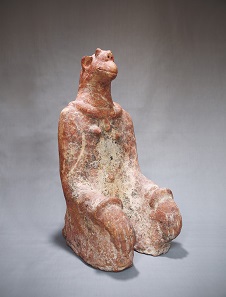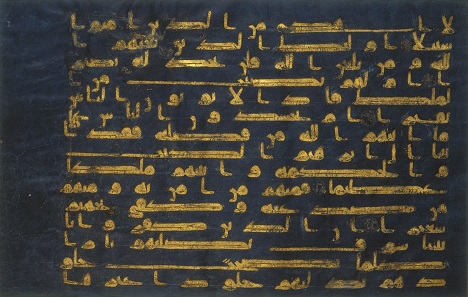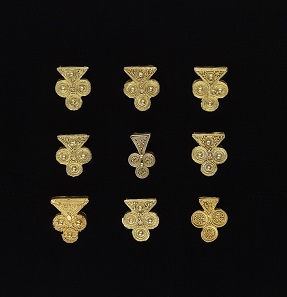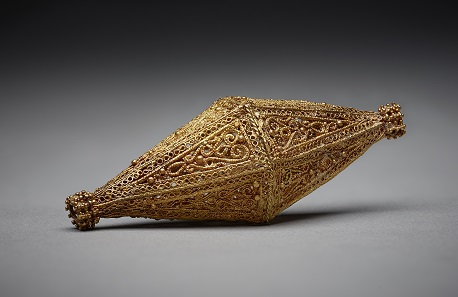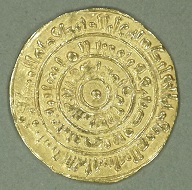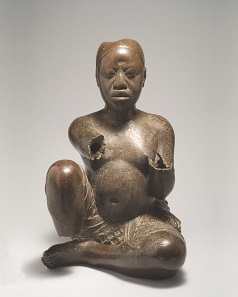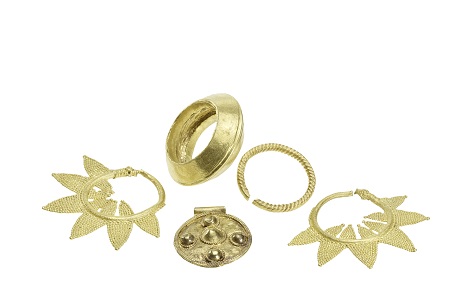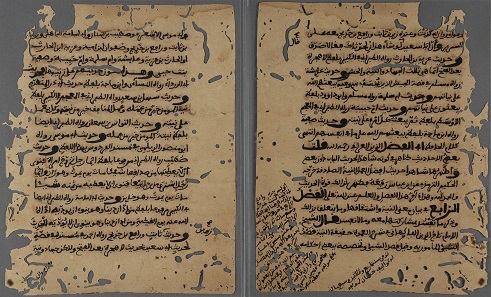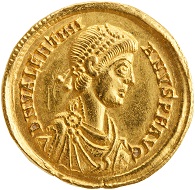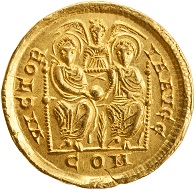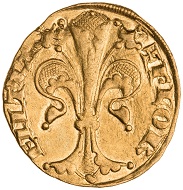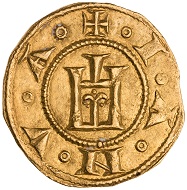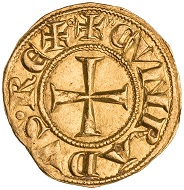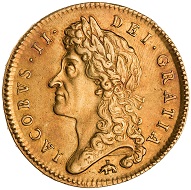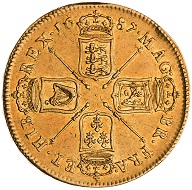February 21, 2019 – The Block Museum of Art at Northwestern University (Illinois) invites audiences to travel to a time when West African gold fueled expansive trade and drove the movement of people, culture and beliefs.
Kneeling Figure, Natamatao, Mopti region Mali, Terracotta, 12th to 14th century, 46 cm x 22.3 cm x 21.5 cm, Musée national du Mali, Photo: Seydou Camara, 90-25-10.
“Caravans of Gold, Fragments in Time: Art, Culture and Exchange across Medieval Saharan Africa” is a first-of-its-kind exhibition that celebrates West Africa’s historic and underrecognized global significance and showcases the objects and ideas that were exchanged at the crossroads of West Africa, the Middle East, North Africa and Europe from the 8th to 16th centuries.
Supported in part by the National Endowment for the Humanities and the Buffett Center for Global Studies, among many funding organizations, the groundbreaking exhibition will travel to Toronto’s Aga Khan Museum in Fall 2019 and the Smithsonian’s National Museum of African Art in Spring 2020.
Page from the “Blue” Qur’an, 9th-10th century. Ink, gold, and silver (now oxidized) on blue-dyed parchment, 28.4 x 38.1 cm. Brooklyn Museum, gift of Beatrice Riese, 1995.51a-b. Photo: Brooklyn Museum, 1995.51a-b_back_IMLS_SL2.jpg.
American literary scholar and cultural critic Henry Louis Gates Jr., host of the PBS series “Africa’s Great Civilizations,” said The Block Museum exhibition is significant and timely. “This is a project that cannot be pigeon-holed as an ‘African exhibition,’” Gates said. “It reaches across boundaries and challenges conventional ideas about Africa, Islam and Medieval.”
Gold Jewelry Ornaments, Tukulor artist, Mauritania, Late – early 20th century, Gold alloy, gift of the Roy and Brigitta Mitchell Collection. Photo: Franko Khoury, National Museum of African Art, Smithsonian Institution.
“The exhibition upends conventional historical narratives of the period by placing the Sahara and West Africa at the center,” he said. “It foregrounds how recent scholarship is compiling these points of reference to build a fuller and more nuanced picture of the period than we’ve ever had before. In doing so it disrupts the usual colonial narrative that begins with the onset of the Black Atlantic slave trade.”
“Caravans of Gold” draws on recent archaeological discoveries, including rare fragments from major medieval African trading centers like Sijilmasa in Morocco, and Gao and Tadmekka in Mali. These “fragments in time” are shown alongside works of art that invite audiences to imagine them as they once were. They are the starting point for a new understanding of the medieval past and for seeing the present in a new light.
Bioconical bead, Egypt or Syria, 10th -11th century Gold; filigree, granulation, “rope” wire L. 7.2 cm, H. 2.9 cm, The Aga Khan Museum, AKM618.
Treasures of the Medieval Period
“Caravans of Gold” presents more than 250 artworks and fragments spanning types, styles and religious practices, representing more than five centuries and a vast geographic expanse. The works, both European and African, convey a story of the global networks and multi-directional trade at play in the medieval world.
Dinar of al-Mustans ir Billah (r. 1036–1094), issued AH 461, struck at Mis r (Cairo). Gold, diameter 22 mm. Bank al-Maghrib, Rabat, Morocco, 521508. Photo: Fouad Mahdaoui.
To tell this little-known history, The Block Museum has secured rare and important loans from partner institutions in Mali, Morocco and Nigeria. Many of these objects have never traveled outside of their home countries. Some are among the greatest treasures of the medieval period in West Africa, including several rare manuscripts from libraries in Timbuktu.
Seated Figure, possibly Ife, Tada, Nigeria, late 13th-14th century, copper with traces of arsenic, lead, and tin, H. 54 cm, Nigerian National Commission for Museums and Monuments, 79.R18. Photo: National Commission for Museums and Monuments, Abuja, Nigeria.
The loans from Nigeria include iconic artworks – such as a near life-size copper seated figure from Tada and a rope-entwined vessel from Igbo Ukwu – that stand alongside the greatest works of art from any region or culture.
Gold jewelry from tumulus 7, Durbi Takusheyi, Nigeria, 13th – 15th century. National Commission for Museums and Monuments, Abuja, Nigeria. Photo: Rene Müller.))
“Archaeologists’ site reports are full of enticing descriptions of material fragments uncovered in towns around the Sahara that were once thriving centers of trade; fragments of lusterware, glass vessels, glass beads, cast copperwork, iron work, terracotta and, occasionally, even goldwork have all been found at these sites,” said exhibition curator Kathleen Bickford Berzock, The Block Museum of Art’s associate director of curatorial affairs. “By placing these fragments alongside more familiar medieval works of art, ‘Caravans of Gold’ conjures an all but forgotten time and place. “With the exhibition, we are inviting audiences to throw out their perceptions of medieval knights and castles and journey with us to a medieval world with Africa at its center,” Berzock said.
Ahmad Baba al-Tinbukti, as dictated to Yusuf al-Isi, The Uttermost Hope in the Preference of Sincere Intention over Action, Timbuktu, Mali, 1592. Ink on paper, 20 x 15.5 cm. Melville J. Herskovits Library of African Studies, Northwestern University Library, Hunwick 541. Photo: Clare Britt.
Impacting Education
Throughout its run, The Block Museum of Art will focus on using the “Caravans of Gold” exhibition as a site for impacting the teaching of African art and history. Ongoing public tours of the exhibition will be held Tuesdays at noon and Sundays at 3 p.m. Free, private tours for schools and community groups can be scheduled through The Block website.
A significant educational initiative supported in part by the Evanston Arts Council, will ensure that students throughout Evanston and the surrounding region have the opportunity to visit the exhibition as a site for learning about Africa’s rich, global history. “The exhibition repositions African states and peoples as not only embedded in, but central to global networks of exchange in the medieval world and challenges common notions of Africa as a place isolated from the rest of the world and without history,” said Lisa Corrin, the Block Museum Ellen Phillips Katz Director. “We will have students asking why this important history, these stories, are relatively unknown and untaught.”
The American Numismatic Society has loaned some fascinating coins to The Block Museum in the context of this exhibition:
Roman Empire. Valentinian II. AD 383-387. Milan. AV Solidus. ANS 1977.158.947. Photo: American Numismatic Society.
Italy. Florence. Gold florin. 1252-1303. ANS 1954.237.214. Photo: American Numismatic Society.
Italy. Genoa. Gold genovino. 1257-1339. ANS 1985.27.1. Photo: American Numismatic Society.
Great Britain. James II. Gold 5 guinea. 1687. ANS 1957.172.19. Photo: American Numismatic Society.
“Caravans of Gold” continues through July 21, 2019 at The Block Museum, 40 Arts
Circle Drive on the Evanston campus.
For more information about “Caravans of Gold” and exhibition related events, visit The
Block Museum website.
Lisbon and the king of Portugal was one of the most important importers of gold. Here you will find an article what they made of this gold.





